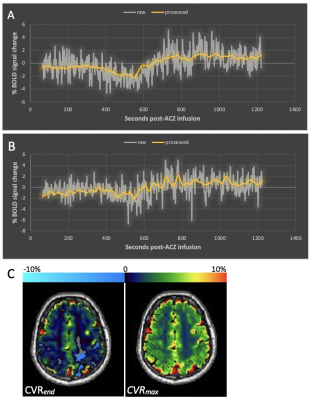Siddhant Dogra1, Xiuyuan Wang2, Jelle Veraart3, Alejandro Gupta3, Koto Ishida3, Deqiang Qiu4, and Seena Dehkharghani3
1Radiology, New York University Langone Health, New York, NY, United States, 2Weill Cornell, New York, NY, United States, 3New York University Langone Health, New York, NY, United States, 4Emory University, Atlanta, GA, United States
1Radiology, New York University Langone Health, New York, NY, United States, 2Weill Cornell, New York, NY, United States, 3New York University Langone Health, New York, NY, United States, 4Emory University, Atlanta, GA, United States
A custom pipeline employing spatial and temporal denoising permits for enhanced dynamic CVR analysis in patients with chronic steno-occlusive disease to uncover otherwise concealed dynamic features of the ACZ-augmented BOLD cerebrovascular response.

Sample BOLD signal (A, B) and representative CVRend and CVRmax maps (C) from a patient with right hemisphere disease. % BOLD-signal changes of a right hemispheric voxel with 30-second temporal delay with respect to the straight sinus time series shown from raw (gray) and processed signals (orange) demonstrating non-monotonic post-ACZ effects. Panel B demonstrates a case with CVRmax greater than CVRend. Panel C demonstrates challenges with CVRend evaluation confounding essentially preserved, symmetric CVRmax augmentation in a patient remaining stable during serial follow-up.

Sample BOLD signal (A, B) and representative CVRend and CVRmax maps (C) from a patient with right hemisphere disease. % BOLD-signal changes of a right hemispheric voxel with 30-second temporal delay with respect to the straight sinus time series shown from raw (gray) and processed signals (orange) demonstrating non-monotonic post-ACZ effects. Panel B demonstrates a case with CVRmax greater than CVRend. Panel C demonstrates challenges with CVRend evaluation confounding essentially preserved, symmetric CVRmax augmentation in a patient remaining stable during serial follow-up.
